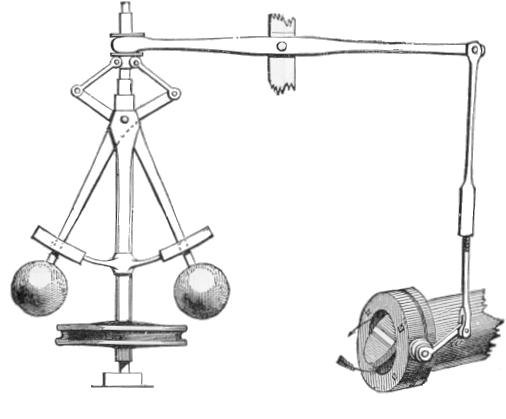
From Bliss Sloan's answers to questions from readers and students...
[EagleRidge Home] | [Resources] | [Sloan] |
What is a Flyball Governor?
Question:
"What is a flyball governor?"
Answer:
Good question. I hope you don't mind if I turn your question into an opportunity to show how much information can be gotten with just a single search online.
Search at Google to find some good flyball governor links:
Use "flyball governor" (without the quotes) as the keywords for Google to find. (Try the above search box; it works.)
Using references returned from the Google search above, I discovered the following:
According to From Conventional to Intelligent Control, "...the governor was introduced in the late 18th century to regulate the speed of steam engine vehicles."

Source: http://commons.wikimedia.org/wiki/File:Centrifugal_governor.png
See also: a picture of James Watt's flyball governor for his engine in "I SELL HERE, SIR, WHAT ALL THE WORLD DESIRES TO HAVE -- POWER", a talk by Dr. John Lienhard of the University of Houston.
We can learn how "a flyball governor (is) used with a hydraulic control" from Questions and Answers for Steam Turbines":
"As the turbine speeds up, the weights are moved outward by centrifugal force, causing linkage to open a pilot valve that admits and releases oil on either side of a piston or on one side of a spring-loaded piston. The movement of the piston controls the steam valves."
Flyball governors are still used; Google found a notice from the 10/21/1999 issue of Commerce Business Daily of a sale (at $39,384!) to United Technologies Corp.
The importance of the flyball governor is put into historical context in Chapter 7 of "Out of Control," by Kevin Kelly, published by Addison-Wesley and online:
"The steam engine is an unthinkable contraption without the domesticating loop of the revolving governor. It would explode in the face of its inventors without that tiny heart of a self. The immense surrogate slave power released by the steam engine ushered in the Industrial Revolution. But a second, more important revolution piggybacked on it unnoticed. There could not have been an industrial revolution without a parallel (though hidden) information revolution at the same time, launched by the rapid spread of the automatic feedback system. If a fire-eating machine, such as Watt's engine, lacked self-control, it would have taken every working hand the machine displaced to babysit its energy. So information, and not coal itself, turned the power of machines useful and therefore desirable.I hope this helps!The industrial revolution, then, was not a preliminary primitive stage required for the hatching of the more sophisticated information revolution. Rather, automatic horsepower was, itself, the first phase of the knowledge revolution. Gritty steam engines, not teeny chips, hauled the world into the information age."
--Bliss Sloan
email: sloan at this domain
Last updated: 10/22/2009